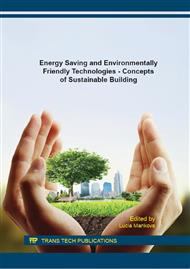[1]
C. Reinhart, A. Fitz, Findings from a Survey on the Current Use of Daylight Simulations in Building Design, Energy and Buildings, 2006, 38 (7) 824-835.
DOI: 10.1016/j.enbuild.2006.03.012
Google Scholar
[2]
BS 8206-1: Lighting for Buildings – Part 2, British Standards Institution, London, (2008).
Google Scholar
[3]
ČSN 73 0580-1: Daylighting in Buildings – Part 1, Český normalizační institut, Praha, (2007).
Google Scholar
[4]
R. Hopkinson, G. P. Petherbridge, J. Longmore, Daylighting, Heinemann, London, (1966).
Google Scholar
[5]
D. Ibarra, C. Reinhart, Daylight Factor Simulations – How Close Do Simulation Beginners Really' Get, IBSA, Glasgow, 2009, 196-203.
Google Scholar
[6]
E. Ng, A Study on the Accuracy of Daylighting Simulation of Heavily Obstructed Buildings in Hong Kong, IBSA, Rio de Janeiro, 2001, 1215-1222.
Google Scholar
[7]
J. Mardaljevic, Validation of a Lighting Simulation Program under Real Sky Conditions, Lighting Research and Technology, 1995, 27(4), 181-188.
DOI: 10.1177/14771535950270040701
Google Scholar
[8]
L. Gábrová, Comparison of Measured and Calculated Daylight Factor Values in Obstructed Room, Juniorstav 2015, Brno University of Technology, Brno, 2015, 1-8.
Google Scholar
[9]
J. Du, S. Sharples, Assessing and Predicting Average Daylight Factors of Adjoining Spaces in Atrium Buildings under Overcast Sky, Building and Environment, 2011, 46 (11), 2142-2152.
DOI: 10.1016/j.buildenv.2011.04.020
Google Scholar
[10]
A. Tsangrassoulis, V. Bourdakis, Comparison of Radiosity and Ray-Tracing Techniques with a Practical Design Procedure for the Prediction of Daylight Levels in Atria, Renewable Energy, 2003, 28 (13), 2157-2162.
DOI: 10.1016/s0960-1481(03)00078-8
Google Scholar
[11]
Technical Report CIE 171: Test Cases to Assess the Accuracy of Lighting Computer Programs, CIE, Bureau, (2006).
DOI: 10.25039/tr.171.2006
Google Scholar
[12]
F. Maamari, Simulation nume´rique de l'e´clairage, limites et potentialite´s, INSA de Lyon, Lyon, (2004).
Google Scholar
[13]
P. Tregenza, Daylighting algorithms, ETSU S 1350, UK Department of Trade and Industry on Behalf of the Energy Technology, 1993, 43.
Google Scholar
[14]
ENTPE – DGCB / CNRS Laboratory, Assessment of Velux Daylight Visualizer 2 against CIE 171: 2006 Test Cases, Vaulx-en-Velin Cedex, (2009).
DOI: 10.18552/2019/idscmt5159
Google Scholar
[15]
Dau Design and Consulting Inc., Validation of AGi32 against CIE 171: 2006, Calgary, (2007).
Google Scholar
[16]
Information on http: /www. edsl. net/main/Software/Validation/Daylight. aspx.
Google Scholar
[17]
Information on http: /www. dialplus. ch/#!df/cvwa.
Google Scholar
[18]
F. Vajkay, M. Hlásková, L. Gábrová, Appropriateness of Test Cases Included in the CIE 171/2006 Test Report, ATF 2014, TGM – Federal Institute of Technology, Vienna, 2014, 228-231.
Google Scholar
[19]
Lawrence Berkeley National Laboratory, Radiance, Berkeley.
Google Scholar
[20]
Relux Informatik AG, ReluxPro 2014, Münchenstein.
Google Scholar
[21]
DIAL GmbH, DIALux 4. 12, Lüdenscheid.
Google Scholar
[22]
ASTRA 92, Wdls 4. 1, Zlín.
Google Scholar
[23]
F. Vajkay, Optimisation of Light Conditions in Buidlings, Brno University of Technology, Brno, (2012).
Google Scholar
[24]
Relux Informatik AG, Relux Light Simulation Tools: Fit for ReluxSuite, (2013).
Google Scholar
[25]
Information on http: /forum. dial. de/viewtopic. php?f=28&t=62&p=76&hilit=wall+thickness#p.76.
Google Scholar


